Introduction
The Solid Studio is an impulse response loader in pedal format that offers two main features: simulations of guitar speakers with an IR loader supporting 2048 samples and a simulation of power amplifiers. This pedal was launched on the market in mid-2018 and was marketed until recently but it was announced as discontinued by Nux. Still, I decided to publish this little review because this charger has interesting capabilities and a few copies remain available through certain resellers (Amazon for instance, as of beginning of September 2022). And of course, you should be able to find it on the used market, if you are interested….
Solid Studio : overview
The pedal comes in a solid blue case of about 10 cm*10.5 cm. The manufacturing quality seems to be quite good: the enclosure, the connectors, the potentiometers and the other switches are robust and responsive.
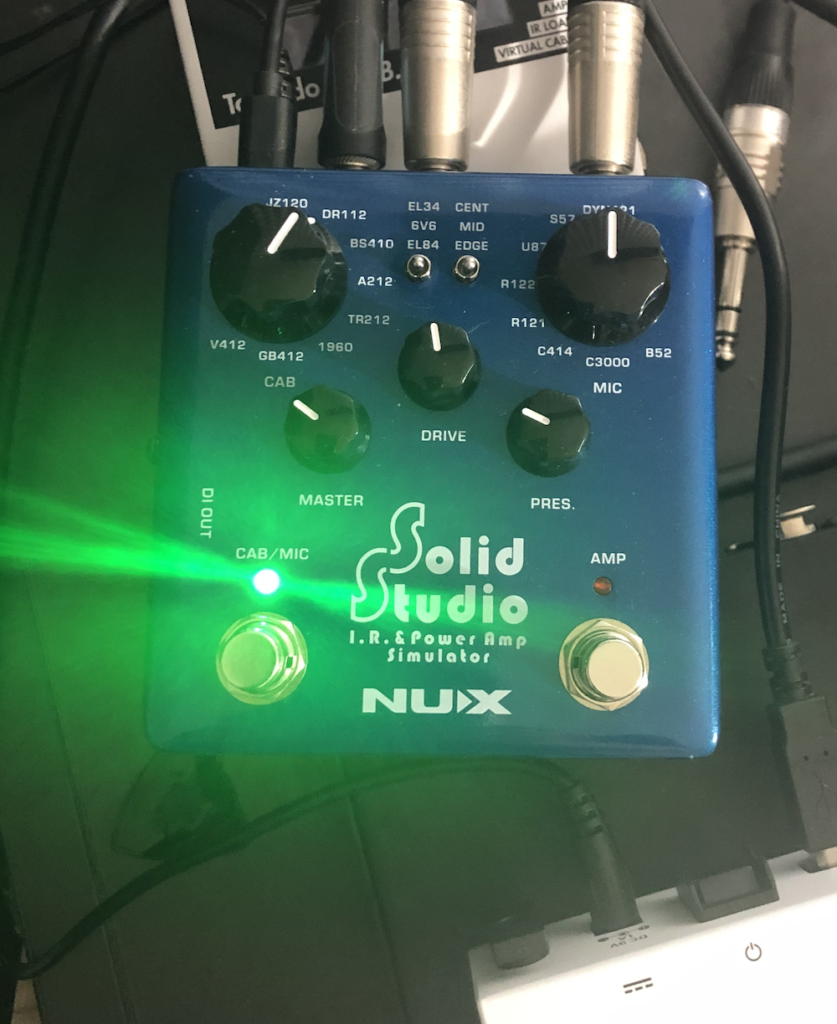
In my opinion, the two main advantages of this pedal are :
- simple and direct parameter control using potentiometers and switches: no screen, no menus or sub-menus
- a good sound quality and a rendering of impulse responses which seems fairly faithful to me
The following pictures are taken from the Solid Studio manual :
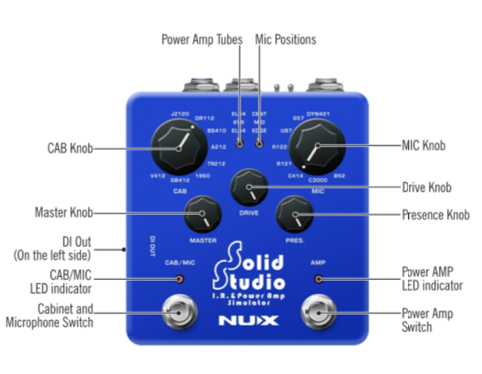
The two footswitches control cabinet simulation activation (on the left) and power amplifier simulation activation (on the right).
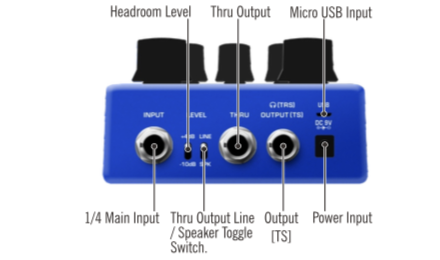
The pedal weighs just under 500 grams and requires a 9 volt power supply delivering 240 mA.
The main technical characteristics are as follows:
- Sampling frequency : 88,2 kHz
- Analog/numeric conversion on 32 bits
- Frequency response : 20 Hz – 20 kHz +/- 0,5 dB
- Dynamic range : 100 dB
- Latency : 0.7 ms
The pedal operates internally at 88.2 kHz and offers support for IRs with a length up to 2048 samples (i.e. 46 ms), which allows it to offer an excellent rendering of IRs. For comparison, the Mooer Radar, the Ampero (first one) or the Quad Cortex support IRs of 1024 samples (i.e. 23 ms). The Torpedo Cab M and CaptorX go further and support IRs of 20, 40, 100 and 200 ms.
The Solid Studio provides 4 connectors:
- Input : connect a pedal, an amp FX send or an amp speaker out*
- Thru : output the DRY signal (see connection diagrams below)
- Output (TS) : unbalanced output of processed signal
- Output XLR (left side of pedal) : balanced output of processed signal
*WARNING : the Solid Studio pedal IS NOT A LOAD BOX. If you connect a speaker output to the pedal input you MUST activate SPEAKER mode (“SPK”) on the switch on the back and you MUST connect the THRU output to a guitar speaker of the impedance expected by your amp or a load box, otherwise your amp will be damaged.
A micro USB connector is also available on the back side, in order to configure the pedal via a small software provided by Nux: you will need it to load your custom IRs on the pedal.
Notice also that the pedal has a sensitivity and headroom adjustment switch available, labeled +4db or -10db, set it according to the level of the signal you send to the pedal.
Connections
The pedal can be connected according to different scenarios, which will allow you either to apply the cabinet simulation to your signal, possibly associating the power amp simulation, or to get the input signal in the same way as a “DI” box. So you can imagine connecting to it in different ways:
- using distortion pedals or pre-amp type pedals or even a multi-effect (by deactivating the speaker simulation of the multi-effect)
- using the pre-amp part of a guitar amplifier (FX send) with optional signal return to FX via the THRU connector, which can allow you to record in “silent” mode, by leaving your amp in stand-by (*)
- using the speaker output of your amp: the switch must then be set to SPK, and you can connect the pedal either between your amp and your speaker, or between your amp and a load box.
- and finally using the output of a load-box: in this case, you will connect with a line level signal and you have to set the switch to the LINE value (and no longer SPK).
(*) Warning: some amps will not support this : the stand-by can also turn-off pre-amps, depending on the exact model of your amp
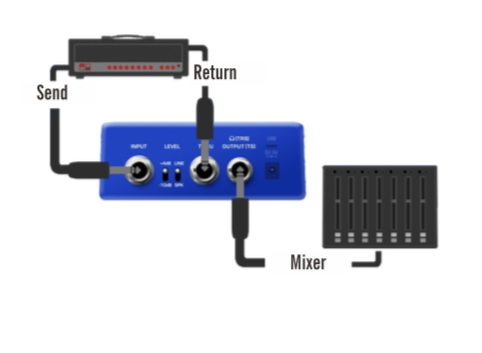
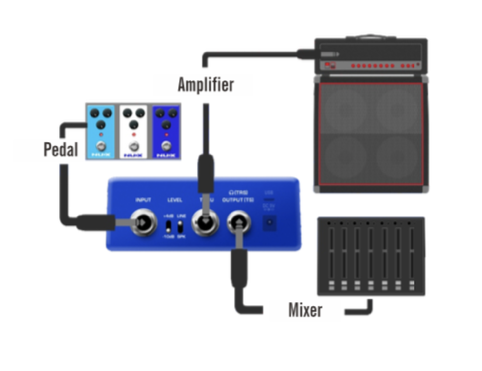
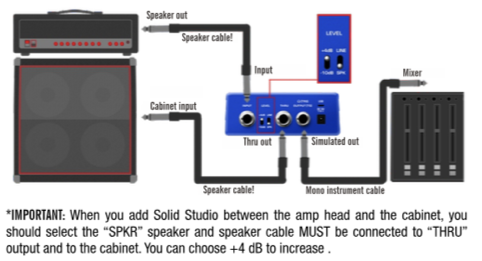
For scenarios where you are not entering the pedal with a power amp signal, i.e. when using distortion pedals or preamp pedals or even the FX Send connection of an amp, you can activate the power amp simulation section, with EL34, 6V6, or EL84 tubes.
If you connect to a preamplifier in FX Send/FX Return mode without activating the cabinet simulation, you will get the direct signal from the preamplifier (which could be referred to as an preamp “DI” mode). You can also do the same with the SPEAKER output and you get a full signal (which you can route to your sound card and DAW) but remember that you will need to have a load connected (load-box or cab).
The IR loader
The Solid Studio comes with 8 speakers, with 8 microphones and 3 positions (central, cap edge, edge), i.e. 192 locations. These slots are loaded with Nux “factory” cabs: each of them can be replaced by one of your IRs, that you can load on the pedal.
These factory cabs sound pretty good, and the choice of pickups is interesting. For information, here is the list of the original CABs and microphones, which you find directly on the pedal via the two notched buttons on the left and right.
Guitar cabs :
- JZ120 : Roland Jazz Chorus 120
- DR112 : Fender Deluxe Reverb 112
- BS410 : Fender Bassman 410
- A212 : VOX AC30 212
- TR212 : Fender Twin Reverb 212
- 1960 : Marshall 1960 412
- GB412 : Celestion Greenback 412
- V412 : Celestion Vintage 30 412
Microphones available:
- DYN421 : Sennheiser MD 421
- S57: Shure SM57
- U87 : Neumann U87
- R122 : Royer R122
- R121 : Royer R121
- C414: AKG C414
- C3000 : AKG C3000
- B52 : Shure Beta 52
3 positions are available for each cab/mic, from the lightest tone to the darkest tone via the CENT/MID/EDGE switch.
The last 3 cabs on the list give quite good results for high-gain tones.
The power amp simulation
Three “colors” or flavors are available: EL34, 6V6, EL84. The latter did not convince me too much, because it gives a very clear sound and is a little bit too “thin”, at least for the sounds that I like to use. That being said, it could be interesting for very low tunings and djent and other very dry sounds lovers. The other two simulations provide good results : the EL34 version puts the mids forward and gives some resonance and substance to your signal. The 6V6 option gives a more “US” coloring to the sound and will scoop your mids.
The power simulation is controlled by 3 potentiometers: Master / Drive / Presence. The two Master and Drive potentiometers interact and impact the overall level of the signal (Drive brings a little additional distortion and more or less resonance and strongly impacts the volume of the simulation).
The EL34 and 6V6 simulations provide good results on high-gain sounds – according to my tastes -. I would have preferred a 6L6 simulation instead of the 6V6, but this 6V6 is quite usable and can give you a lot of resonance at the low-end of the spectrum….
Loading your IRs
IR loading can be done by using the software provided by Nux, which allows you to control the pedal via its interface (changing the selected cab, microphone selection, amp sim on or off, speaker simulation on or off…: obviously , the potentiometers will be desynchronized if you change the parameters from the software, but a simple manipulation of the potentiometers takes precedence and resynchronizes the software).
No issue when loading my own IRs, OwnHammer IRs, those of Catharsis or the free IRs of Wilkinson Audio.
After loading, your IR becomes available and the software offers you a frequency response graph. An additional button in the interface allows you to reinstall the original IR in the slot.
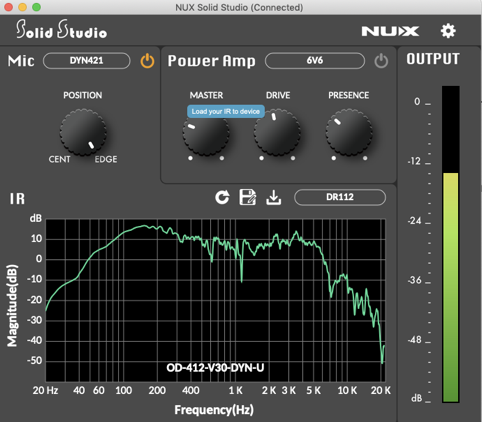
Small tip: the number of characters is limited (file names are often truncated) but you can edit it with a click on the text area:
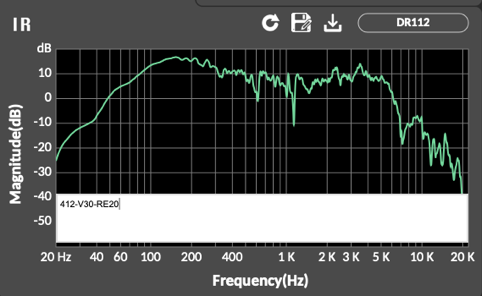
How does it sound ?
It sounds great and seems quite close to the results I get with Nadir or Libra through my sound card.
Here are some very simple examples in different configurations:
- Wampler Triple Wreck with power amp sims
- Dual Rectifier power sim off
- Dark Terror power sim off
- Dark Terror preamp only
All samples done with a 7 strings guitar tuned to B, with Fishman Fluence modern and a Precision Drive from Horizon Devices.
Strengths and weaknesses
The Solid Studio is not perfect: the biggest criticism I could make of it is that it does not offer volume management when you are not using the amp simulation. You simply choose the input level (+ 4/-10) and it is the input volume in the pedal and the following equipment that will allow you to obtain the desired sound level. This can be restrictive.
In the case of an amp output, the headroom is limited (2 positions): you can clip the input of the pedal quite quickly, with a relatively low output level on a tube amp (1/4 master on a 100 Watt Dual Rectifier).
For comparison, a Torpedo CAB M will offer more flexibility in this area, with 3 input levels and output volume management.
There is no EQ, no low-cut or high-cut, no low-shelf or high-shelf: it is the IR, pure and simple….You will need to take note of which custom IRs has been loaded into which slot when you are not using the software: this is the price to pay for the “buttons and switches” approach…: )
If the EL34 simulation is quite good and easy play with, the 6V6 one is a little more difficult to use: on IRs that have a fairly high volume, the combination of a high bass level with the 6V6 simulation can cause sagging/compression effects if you abuse the drive level (which I frequently keep at a minimum for the 6V6, but this also seems to depend on the voicing of the IR and its volume..…).
No headphone output, that would have been a great plus….
On the other side, the pedal provides good capabilities: imperceptible latency, good sound quality -especially with pedals or the use of an FX Send-, a good/precise rendering of IRs, the ability -even limited due to the headroom- to use an amp output, and a pedal ergonomics with easy and direct use (buttons, switches and that’s it!). Also two good power amp simulations, to enrich the rendering of your pedals or your pre-amps….
Conclusion
There is room on the IR loader market – in my opinion – for hardware chargers of this type, offering good rendering of IRs (2048 samples/46 ms) and traditional pedal ergonomics. The Nux Solid Studio will be interesting for those who favor sound quality and are looking for simple ergonomics and direct access via very classic notched buttons and small switches. The ability to use the output signal of an amp is also a big plus compared to other pedals like the Mooer Radar, even if the Solid Studio remains limited in this area and that a load-box will -finally- prove essential, in order to be able to exploit this type of hardware in “silent” mode (via monitors or headphones, and without a guitar cab connected). Don’t buy it if you plan to use an amp that needs the master to be pushed hard, unless you first go through a load-box to enter with a line level in the Nux pedal.
If you want to get started with IRs and value sound quality over features, or want better tone than what you get with more limited hardware (an existing charger or an entry level multi-effects for example), if you are allergic to screens and push buttons, for studio/home studio use or small live, and if you rather use pedals -distortion or preamp pedals (*)-, then the Solid Studio may prove interesting for you, especially if you find it at a competitive price, on the used market for example.
(*) using an amp in live situations seems difficult if you plan to plug it to the pedal and then to a guitar cab, due do the limited headroom mentioned earlier…
NOTE: to fully use your IRs on this pedal, you may need to also leverage software such as SuperCabinet or Libra to prepare your IRs (due to the absence of EQ / volume/low-cut/hi-cut on the pedal). But this can apply to other IR loaders as well.
If you want to access this level of sound quality with more features and flexibility (EQ, volume, presets, more flexible and numerous power amp simulations, etc.), then take also a look at the Torpedo CAB M+ (pedal/ preamp/amp in non-silent mode) or at the Torpedo CaptorX (load-box + IR Loader). The budget may not be the same. For more reasonable budget, you could also be interested in the small charger launched by TC Electronic at the beginning of the year….
As mentioned in the introduction, the product is discontinued by Nux, so be warned that there will probably be no more firmware updates and no more updates of the IR loading software.
Manual, firmware and IR loader software on the product page : https://www.nuxefx.com/solid-studio.html
Additional technical information this Nux blog article : https://nuxefx.blogspot.com/2018/05/ir-impulse-response-feats-nux-solid.html
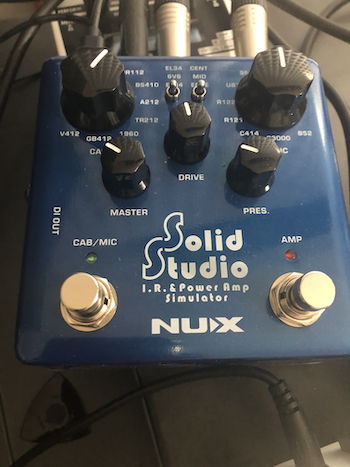
2023-11-15 at 00:33
Just bought it because of your review, it’s a great product. By the way the output (TS) also can be use as headphone output.
2023-11-15 at 19:01
Thank you for the information Andries, much appreciated !
David
2024-01-08 at 10:46
2048 samples at 88.2kHz is 23 ms though?
2024-01-08 at 17:19
Hey Steven, that is correct 2048@88.2K = 23 ms. But 88.2 K is the internal sampling rate of the pedal converters and Nux clearly states that they support 2048 samples / 46 ms IR for better frequency restitution (see section “Technically, the Most Realistic IR Loader” at https://www.nuxaudio.com/solid-studio.html). So they are using the standard 44K sampling frequency when referring to 2048 and they probably then upsample internally when combining the IR to the guitar signal….
David
2025-01-29 at 23:49
I’ve seen this for £50 on Ebay and I have the TC Electronic Combo Deluxe Preamp – would this be a good investment for home studio entry recording?
2025-01-31 at 21:04
Hello James,
The TC Combo Deluxe has 2 outputs, one with a cab sim and the other which outputs only the amp signal without cab (output 2 according to the doc) : you can use this output to route this preamp to an external IR loader (such as this one, the Solid studio). If you use a soundcard and a PC/MAC and your usage is more home studio oriented, you could alternatively consider a software IR loader (Genome as an example, which can be used as a plugin or standalone). Else, £50 for this pedal seems like quite a good deal (current price new is between 155 – 180 Euros).
Hope it helps
David